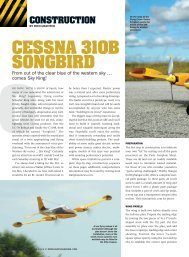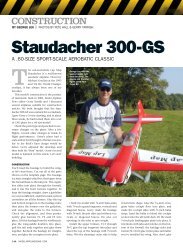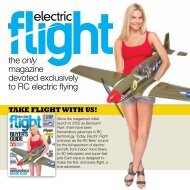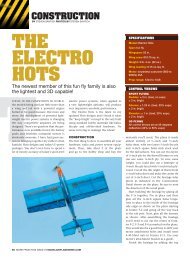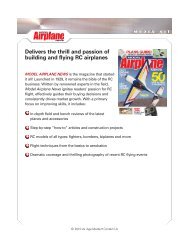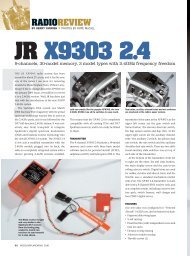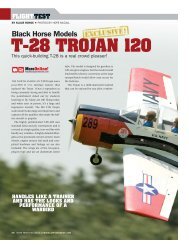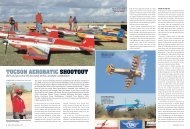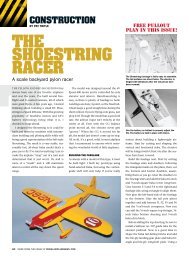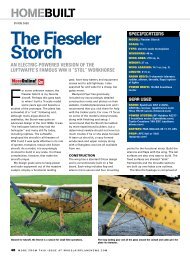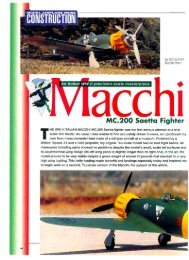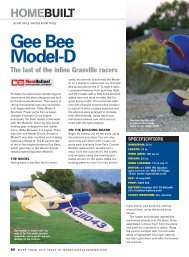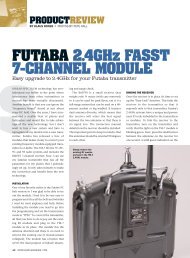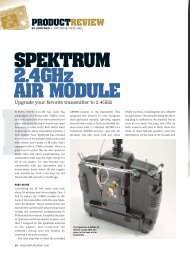Create successful ePaper yourself
Turn your PDF publications into a flip-book with our unique Google optimized e-Paper software.
DESIGN AND BUILD AN RC BIRD MDDEL<br />
A little more sheeting and a couple<br />
of balsa blocks carved to shape,<br />
and you'll almost be finished.<br />
CONTROL<br />
Two methods for pitch control<br />
have been tried—a standard<br />
elevator at the rear of the tail<br />
and the single-piece tail hinged<br />
at the wing's trailing edge. The<br />
elevator at the rear is the most<br />
effective.<br />
Because of the large adverse yaw associated<br />
with ailerons, they don't work well<br />
when there is no vertical tail. A rolling tail<br />
(horizontal tail that tilts<br />
around a longitudinal<br />
axis for controlling turns)<br />
works OK depending on<br />
the CG location but is not<br />
very powerful. If used<br />
with a pitch-stable air-<br />
Here's the completed fuselage ready to cover with<br />
MonoKote. To make it easier to finish, I simply painted<br />
the head and beak.<br />
plane (forward CG), the model flies well,<br />
but the control action is opposite to the<br />
way birds really fly (the model will turn in<br />
the same direction as the tilted tail, but<br />
During the past 11 years, many encounters have occurred between these models and real birds.<br />
Unfortunately, these encounters are usually spontaneous and take place at a fairly high altitude, so I<br />
have no photographic evidence of them.<br />
There are lots of ravens around here; they are gregarious birds, and quite inquisitive. The models<br />
circle easily and climb with the real birds in thermals. Often, one or two ravens fly formation with the<br />
model and follow it as it circles in a thermal (or, just as often, I follow them). Occasionally, one will<br />
come in quite close. Because the wing loadings of the models are lighter than their real counterparts,<br />
the models can fly more slowly. Sometimes, I slow the model to near-stall and then watch as the poor<br />
birds stall or flap off to one side.<br />
One warm, still day, I thermalled a Raven model with about 25 real ravens for about half an hour. The<br />
entire gaggle got so high that I had trouble distinguishing the model from the real birds. I made step<br />
inputs in roll control, and then flew the bird that rolled abruptly. From my notes on the day of the flight:<br />
"Finally I got too high to see well, so I put in full forward trim and flew straight. One bird followed,<br />
matching the model's speed and descent rate, and joined up in formation. I pulled up into a loop. He<br />
watched, then joined up again. I went into a full-up, full-left spiral for about 5 turns to lose altitude,<br />
then recovered. The raven pulled his wings in and did about 3 half-rolls, then some other maneuvers,<br />
then joined up again. I continued trying to descend, and eventually he left.<br />
"The fixed-geometry, under-cambered wing of the models is no match for the refined, variablegeometry<br />
wing of the real birds in straight, high-speed flight. The model quickly drops below and<br />
behind. On several occasions, ravens have followed the model down to about 20 feet altitude, and<br />
then circled overhead squawking loudly as the model lands. One raven landed nearby and walked all<br />
the way around the model (it was probably puzzled by my belly landing}."<br />
I have also thermalled the Turkey Vulture model with real turkey vultures. The appearance and climb<br />
performance were similar, but real vultures aren't as friendly as ravens; they completely ignored the<br />
model.<br />
/ used a 0.063-inch-thick piece of aluminum for<br />
my wing dihedral brace. Note that the fulldepth<br />
spars slide into place in the slots cut<br />
into the brace.<br />
The wing is built with a front and rear portion<br />
glued to the main spar. Here you see the wing root<br />
and the slots in the ribs for the aluminum brace.<br />
no one will notice!). Drag flaps on the<br />
lower wing surface (or spoilers on the<br />
upper surface) also work well for initiating<br />
turns, but they aren't very efficient or<br />
realistic. Since they rely on dihedral effect<br />
to control turns, they often require larger<br />
wing dihedral than that observed on a<br />
real bird.<br />
Wingtip ailerons (feathers) are the most<br />
bird-like roll-control method. They are<br />
very sensitive to the initial incidence setting<br />
of the two ailerons. I use a bias control<br />
through the throttle channel to help<br />
locate the proper angle in flight. For land<br />
birds, use the forward three feathers as a<br />
single aileron surface that rotates around<br />
a spanwise axis (detailed on the plan). For<br />
sea birds, use the outer 22 percent of the<br />
semi-span as an aileron, rotating around a<br />
I've had the most fun with hawks. They will dive at any of the models (raven, seagull, or turkey vulture) from out of nowhere. They have never touched or damaged a model but<br />
usually go screaming by with their wings folded. I once watched a hawk regain altitude<br />
after the attack and then begin circling off to the side. He stayed there until I did something<br />
abnormal, such as a stall, with the model. He then folded his wings and came right<br />
at the model, aborting at the last minute. I triggered three attacks this way. Apparently,<br />
the hawks thought they were watching a wounded or sick bird. Recently, a hawk zoomed in<br />
and established a position directly above the seagull model just a few inches away. He<br />
stayed in that position for about 15 seconds as I made turns with the model. Eventually,<br />
he flew away. I expected to find claw marks on the model but saw no evidence of any contact. Hawk attacks on the Turkey Vulture model are more cautious—usually from above<br />
and directly behind. They fly in trail with the model for awhile until they are satisfied that I<br />
it is not a wounded, easy target. I hope to eventually install one of the new, tiny video cameras in a model to document<br />
some of these encounters-up close and personal.<br />
90 MODEL AIRPLANE NEWS<br />
'ere, the two wing panels have been joined. Note the reflex<br />
hape of the airfoil. The wingtip aileron feathers and the<br />
'ding-edge sheeting still have to be installed.



